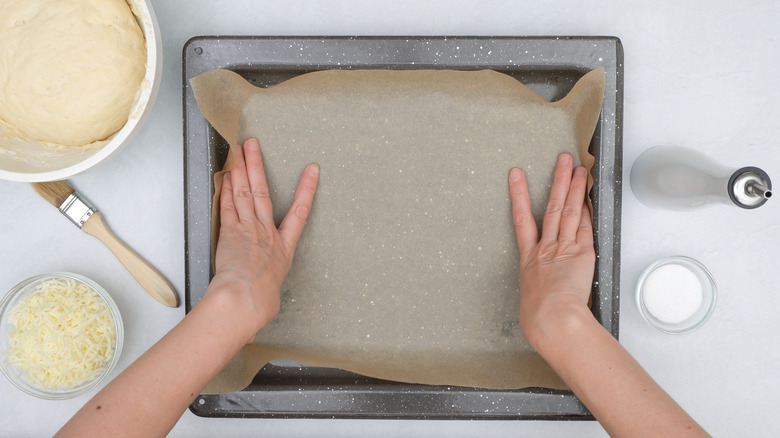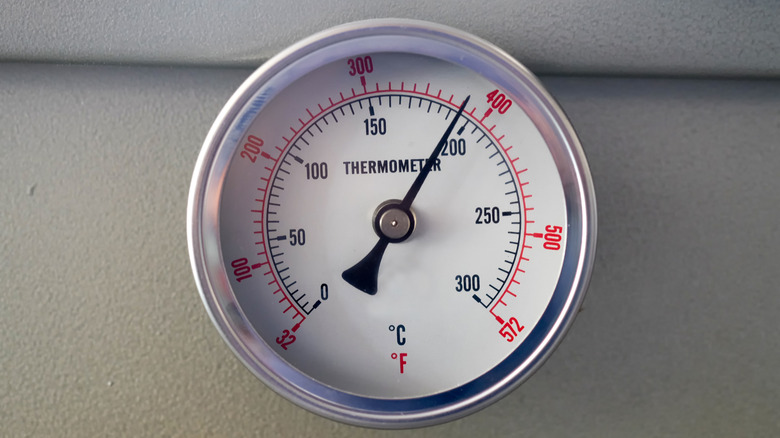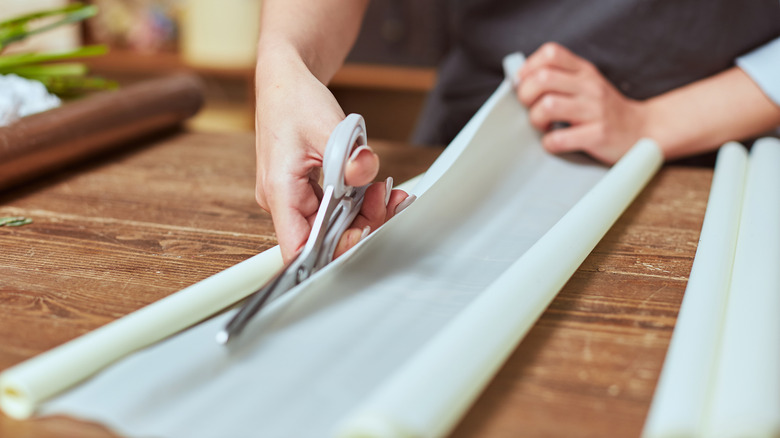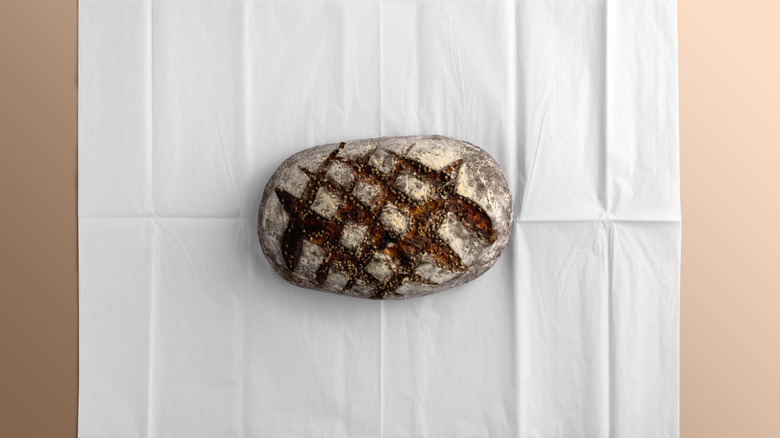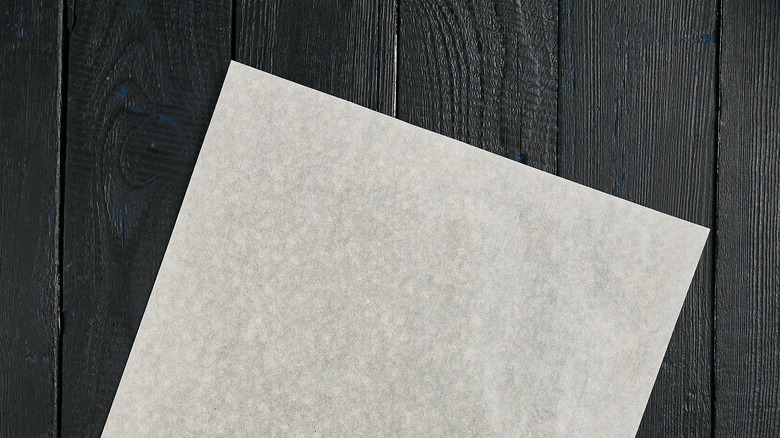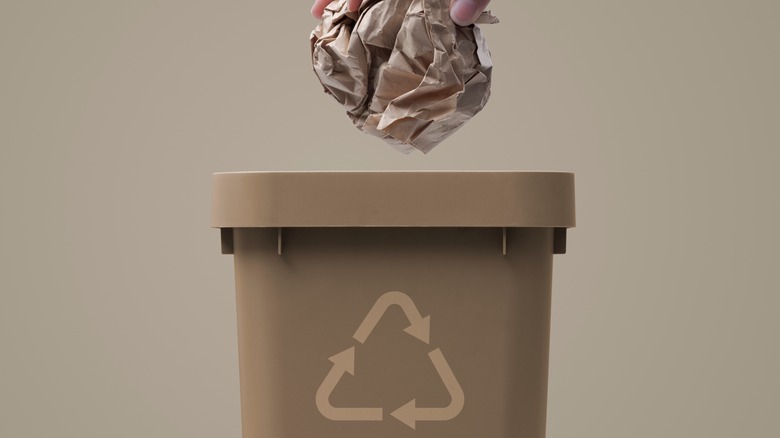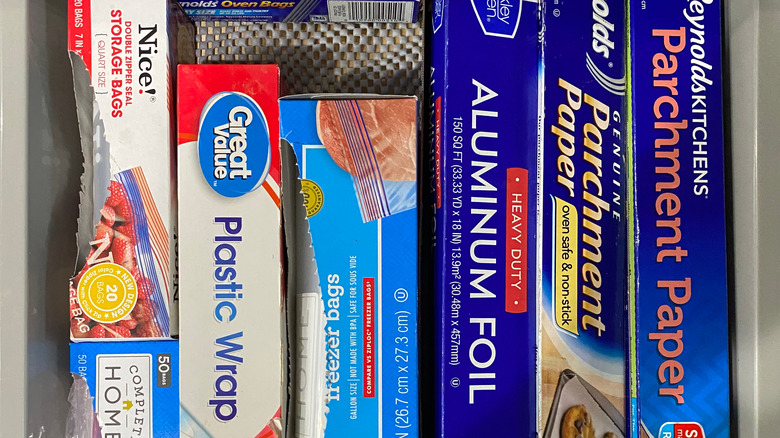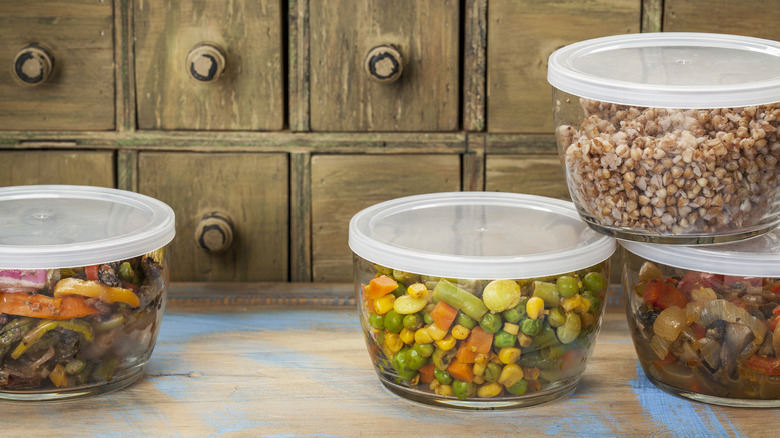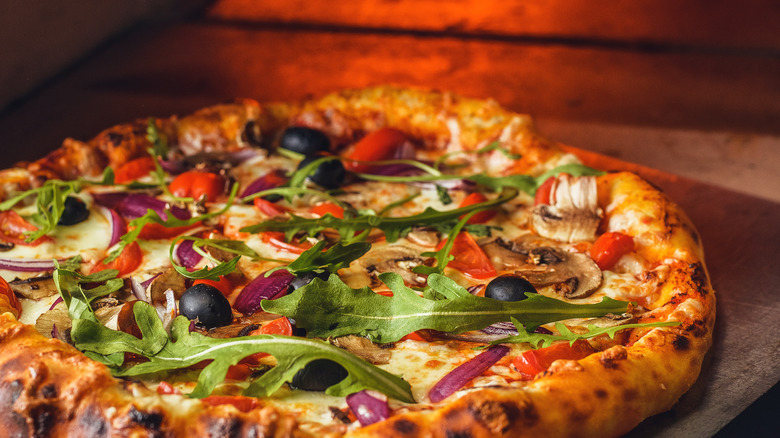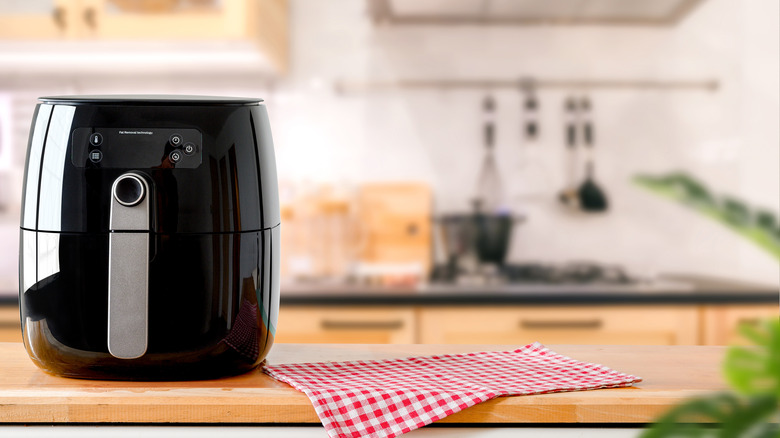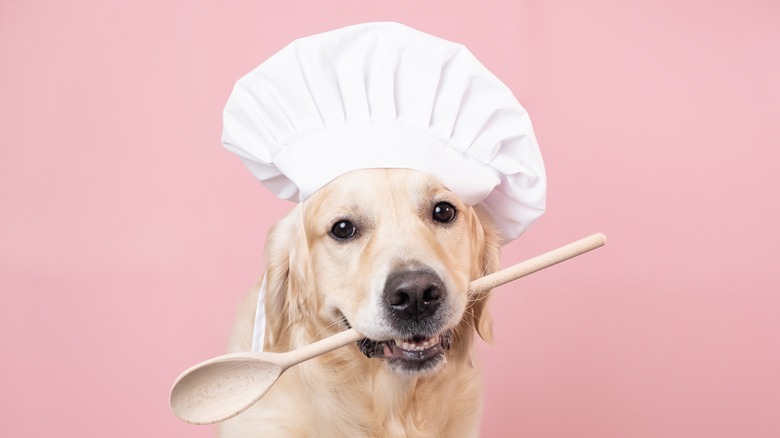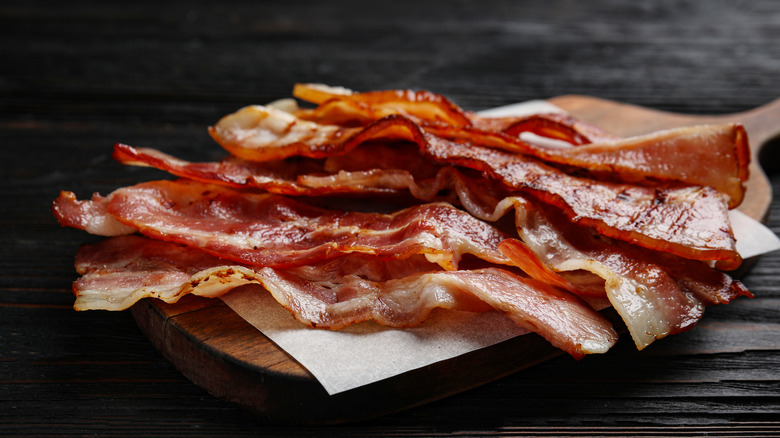12 Mistakes Everyone Makes When Using Parchment Paper
We may receive a commission on purchases made from links.
Are you someone who can't take the heat of the kitchen? Perhaps you've dealt with too many sticky messes, too many burned creations, and altogether have found that cooking incites an impassioned desire to hurl your baking sheet out the window. If you've felt a similar frustration, you are not alone. Thankfully, parchment paper is here to save the day! (Or, at least the meal.)
Parchment paper is a useful kitchen "must-have" that has helped chefs and bakers since the 1800s when the first non-animal variety was introduced. Parchmentpaper.com provides the history of this useful cooking tool and tells us that originally, it was created with sulfuric acid, water, and ammonia. While those ingredients are not particularly appetizing, it has thankfully come a long way since then. Now, most varieties you find are made with cellulose (wood fibers) and coated in silicone. The benefit of its current composition is that silicone is heat resistant, grease resistant, and perfect for neat and tidy preparation! This is much more appealing than having 1800s ammonia leaching into your food!
A key to making the most of parchment paper is knowing how and when to use it! With proper techniques, it can make your cooking and baking ventures a tidy breeze. Just be careful to avoid these common mistakes.
1. Using it at the wrong temperature
Parchment paper is an excellent tool for baking and can be used for anything from cookies to cakes, and entrees. It is oven-safe, but not all temperatures are created equal. This likely doesn't come as too much of a surprise, considering parchment paper is, well, paper. According to the label on Reynold's brand parchment paper, it is oven safe and well-equipped to withstand temperatures up to 425 degrees Fahrenheit. The risk of cooking at higher temps comes fraught with the likelihood of starting a fire. (And not the trendy, "wow, your cooking is fire!" kind).
If you want to avoid the risk of destruction and drama in the kitchen, play it safe and keep your parchment paper creations to temperatures under 425 degrees Fahrenheit. If your recipe demands a higher temperature, opt for an alternative liner like aluminum foil, or just cook straight onto the baking sheet or dish. This isn't quite as easy to clean, but it won't burst into flames and ruin your evening, so that's worth something.
2. Not cutting it down to size
Another common mistake people make with parchment paper is forgetting to cut it down to size. By cutting your parchment to fit your pan or dish, you make sure the lining will be even, and also help to reduce waste.
Some recipes benefit from the lining method more than others. For example, when you line a cake pan with a large piece of parchment, it is best to trim it so that it just fits on the bottom. If you use a full piece of paper without trimming it down, you may end up with extra paper hanging out of the sides of your pan. This can result in burnt edges on your paper, and potentially creases in your cake if the paper fits awkwardly into the bottom of the pan. To achieve a smooth finish on all sides, make sure you cut it down to just fit in the pan, like Blue Flame Kitchen demonstrates.
For a round dish, for example, you'd cut out a disc shape that lies flat on the pan's base. This helps to avoid a "soggy bottom," as the "Great British Baking Show" judges would say, and this method ensures that you won't lose any of your beautiful cake's surface to the pan. Additionally, it helps keep any grease or runoff on the paper, versus having it seep into the actual pan. This will give you an easy clean because you can simply remove the paper and not even need to wash the pan.
3. Forgetting to fold the edges
In addition to lining your dish for easy cleanup, sometimes it is also handy to fold your meal into a parchment paper packet! (Try saying that five times fast). According to Food Network, this technique is known as "En Papillote," which means "in paper" in French. You can also refer to it as "Al Cartoccio" which is the Italian translation.
Certain dishes may do best in this sort of pouch, where you bundle up the ingredients into the parchment paper, and then seal the edges to keep all of the goodness inside. This works especially well for entrees involving meat and vegetables. When you want all of the flavors to integrate and cook together with minimal mess, a parchment paper packet might be just the ticket!
To accomplish this, you would lay the parchment paper flat, and place your ingredients and seasonings into the center. Then, you would fold up the edges, create a tent at the top, and fold or crimp the edges all around. Make sure that you fold them a couple of times to avoid any leakage, and voila! You will gain the result of a clean pan, and yummy, integrated flavors.
Finally, top it all off with a fancy announcement that you have prepared your meal "En Papillote!" If you're cooking for a date who doesn't speak French, then in addition to delicious food, you get to serve up a dish of cultured mystery and intrigue. Magnifique!
4. Leaving the wrong side facing up
Just like you want your culinary prowess to shine, the parchment paper should as well! Make sure to keep the shiny side facing upward when you cook with parchment paper. This is the silicone/nonstick side, and therefore the side that the food should have contact with. The US Department of Agriculture explains that parchment paper (as we mentioned earlier), is mostly made of cellulose. Parchment paper has no smell or taste, and is usually made from plant fibers like cotton or wood. Most parchment paper today is made from chemical wood pulp. The waxy or slick coating is often made from silicone, although some brands use other ingredients to cater to specific needs.
By keeping the slippery side facing upward, the food should easily come off when it's time to serve up your meal. If you forget and flip the paper the wrong way, remain calm. Your meal will likely still turn out okay, but won't necessarily be as clean to remove.
5. Using it only once
Waste not, want not! Many people make the mistake of using their parchment paper once and then tossing it. As King Arthur Baking Company tells us, you can easily and safely use a sheet of parchment paper more than once. Considering it is often used for low-mess foods, more times than not, you can simply brush it off or wipe it off, and use it again.
This tactic works especially well with cookies and similar baked goods. They usually don't leave much of a mess behind after cooking, and may just leave you with a few crumbs. This is a perfect instance where you should reuse, and recycle! Even if your parchment paper's edges got slightly burnt or singed, it should still be safe to reuse. While parchment paper is not outrageously expensive, it is still valuable to save where we can, by reusing it when it's appropriate.
To know when it's time to finally say farewell to a piece of parchment, King Arthur Baking Company recommends that you pay attention to when it starts to crack or become brittle. Once it starts to fall apart on you, it is best to throw it out. Until then, reduce, reuse, and recycle. You can save some money, and maybe even save the world by going green with this tiny habit!
6. Thinking there is only one kind
Did you know that there are different kinds of parchment paper? While you may only see a few brands during a general shopping trip, there are actually several unique options to choose from when you want to get a fresh roll of parchment paper.
Most people are aware of traditional brands like Reynolds, Glad, and store-specific brands, but there are several other, lesser-known brands as well. Buyifyoucare is a great organization that caters to all of the eco-conscious individuals out there. The brand offers parchment paper like this one, which is bleach-free, chlorine-free, and does not involve any animal testing. It also places a strong emphasis on maintaining ethical production practices and making sure that their manufacturing locations do not contribute to the pollution of lakes, rivers, or streams.
Another lesser-known parchment paper is the compostable kind! Kana sells several parchment paper options that you can add to your garden's compost bin once you're done using it. Additionally, it makse its parchment from 50% recycled materials. If you're the type of person who has reused your parchment sheet until it fell apart, and still feels bad about its remains going to a landfill, just know that compostable and sustainably-created parchment paper is out there for you!
In addition to the specifically-marketed compostable paper, Help Me Compost explains along with some useful tips, you can also (usually) compost parchment paper as long as it is unbleached, unwaxed brown paper, and fairly clean.
7. Mixing up parchment paper and silicone paper
Present-day parchment paper is typically coated in a layer of silicone, which gives it that helpful non-stick feature. It should come as no surprise then, that some people mix up parchment paper with silicone sheets, which can also be used for baking.
Silicone paper, or silicone sheets are a different product from parchment paper. They are made completely of silicone (similar to spatulas you may have lying around), and are reusable, dishwasher safe, and are an alternative to disposable liners like parchment paper, aluminum foil, and wax paper. Companies like GIR make a silicone baking mat which is BPA-free, and pharmaceutical grade, and markets it as a great alternative to limited-use products. However, while parchment paper and silicone sheets may seem to serve the same purpose, there are some key differences to be aware of. First, is re-usability. While parchment paper can be reused until it burns or crumbles, silicone baking sheets can be reused up to 2,000 times. So, they are a potentially great option for the highly eco-conscious people out there.
Silicone sheets may also be appealing to people who make their own dough and baked goods. Sometimes, parchment paper can crumple and wrinkle in this process, whereas a silicone sheet will stay in place better. A third difference is sizing. Some companies like NonToxU offer custom sizing for the silicone mats, making them a great match for certain pans, with no paper trimming needed.
8. Forgetting that parchment can hold leftovers
Parchment paper is often thought of as a go-to option for baking and cooking, as it should be. But, did you know that it can also be used to store leftovers and fresh food? Parchment paper has been useful for preventing food spoilage for many years, even as far back as 1889, when a local Kansas newspaper clipping gave it a shout out for its storage benefits. They specifically highlighted parchment paper as a great option for packing butter to prevent spoiling, but you can also store other foods just as effectively.
Foodprint shared that Americans throw away a fourth of the food that they buy. This amounts to anywhere from $1,350-$2,275 of wasted food funds (and likely even more now, with 2023 grocery prices). Therefore, it's helpful to know that parchment paper can save your food, and save you some money. To get the most out of this storage method, you need to prep the food accordingly.
Certain items will store better in different conditions. For example, strawberries hold up the longest when stored in separate layers, with a paper towel to absorb excess moisture. Celery stays its crispest when wrapped in tinfoil, and can be rejuvenated by placing its stems in a glass of water. Mushrooms do best when wrapped in parchment paper, or a paper bag. There are lots of tips and tricks for food storage online, and many of them remind us that parchment paper can be a real food-saver.
9. Using parchment paper on a pizza stone
Who doesn't love a delicious slice of homemade pizza? Some people are truly living the dream, and have their very own pizza oven or pizza stone to cook with at home. This gives homebody pizza chefs a great chance to find the perfect supplies for the perfect slice. You might think that since parchment paper is great for baking, it's great for a pizza stone, but actually, that is not the case. One of parchment paper's main limitations is temperature. With parchment paper's limit extending up to 425 degrees Fahrenheit, you will run into issues with a pizza stone.
According to Napizza, a proper pizza oven will reach nearly 800 degrees Fahrenheit and can go even higher for other styles of pizza, even up to 900 degrees. Such temperatures are not compatible with our little 425 degree-tolerant parchment paper.
In a pizza oven or on a pizza stone, parchment paper may also mess up the crust. To get the crunch that pizza chefs crave, the dough needs to make direct contact with the (piping hot) oven. And, according to Napizza, parchment paper results in more of a "charred leather" outcome.
Luckily, Pizza Companion reassures us that especially in the case of frozen pizzas or leftover slices, parchment paper is a helpful option. As long as you stay within the temperature limit, parchment paper can still be a friend of pizza, just as pizza is a friend to your taste buds.
10. Not using it in the air fryer
The ever-trending air fryer has taken our social media feeds by storm, with countless recipes, tips, and inventions. What is not as commonly known, is that parchment paper can be used in your air fryer to end up with even less mess, and perhaps even better food. The author of Airfryguide goes through some helpful tips when taking advantage of this parchment paper partnership.
For example, you should remain mindful of temperature. Most air fryer recipes keep temperatures under 425 degrees, but it's still helpful to double check before putting in your parchment paper. The last thing you want is an air fryer fire on your hands, because while it may rhyme, it would not be cute. You should also avoid using the parchment paper during the preheat phase of air frying, because it would not yet be weighed down by the food, and could potentially fly around in there and burn on the heating element.
If you want to stock up on parchment paper for your air fryer needs, there's a handy product out there that makes it super easy. Pre-cut air fryer parchment squares, like these from Amazon come with perforated papers, already cut, with various sizes to fit different air fryers. They're relatively cheap, and could save some time if you don't feel like dealing with the traditional roll of parchment paper.
11. Forgetting your hat
You are probably thinking of one of those fancy, tall, white, chef's hats, or a baseball cap. While those are completely lovely if they're your speed, the hat in reference is actually the lesser-known parchment paper hat. It is also known as a parchment paper lid, but calling it a hat is so much more endearing.
As cute as it may sound, the parchment paper hat is a useful method for dishes that tend to burn, or for dishes that you want to be crispy on top. Meillerur Du Chef has a helpful step-by-step of how to make and use a parchment paper lid. For this method, you would fold the paper to fit the surface of your pan or dish (different from measuring for the inside of a pan, as discussed above). Once it fits on the surface, you must open the paper so that it forms a hole in the center, or a chimney of sorts. This allows steam to escape, while protecting the rest of the surface from burning or becoming soggy. Parchment paper is superior to aluminum foil, wax paper, or the lid of the pan or pot here, because it allows the food's moisture to vent steam, while still protecting its surface.
A related use of parchment paper is the fancy and functional cartouche, which traps the right amount of steam for dishes involving sauces, stews, and braised meats.
12. Not using it for bacon
Bacon lovers, if you have not yet cooked your bacon on parchment paper, you should immediately go forth and try it, the moment you finish reading this article.
Whether you like your bacon chewy, crispy, or somewhere in-between, parchment paper can help you achieve the perfect finish, without a greasy pan to clean up later. A dedicated bacon fan at TheKitchn took time to complete an entire study to compare eight popular bacon cooking methods. These included sous vide, in the air fryer, microwaving, baking on a rack, with water in a skillet, bare in a non-stick skillet, bare in a cast-iron skillet, and in the oven on parchment paper. She tried each way twice, and with a different cut of bacon, so the methodology was arguably thorough. In the end, she found that parchment paper was the obvious winner, with a score of 10/10 for texture, time, preparation, cleanup, and visual appeal.
To try out parchment paper bacon this weekend and win the bacon-fueled favor of your family, check out this article for some additional tips. Once you're ready to clean up, you can simply ball up the paper and toss it in the trash. Please note that this would not be the best time to reuse your parchment paper, and also please make sure you don't pour the grease down the drain. Otherwise, the parchment paper bacon-baking is sure to be a success.
